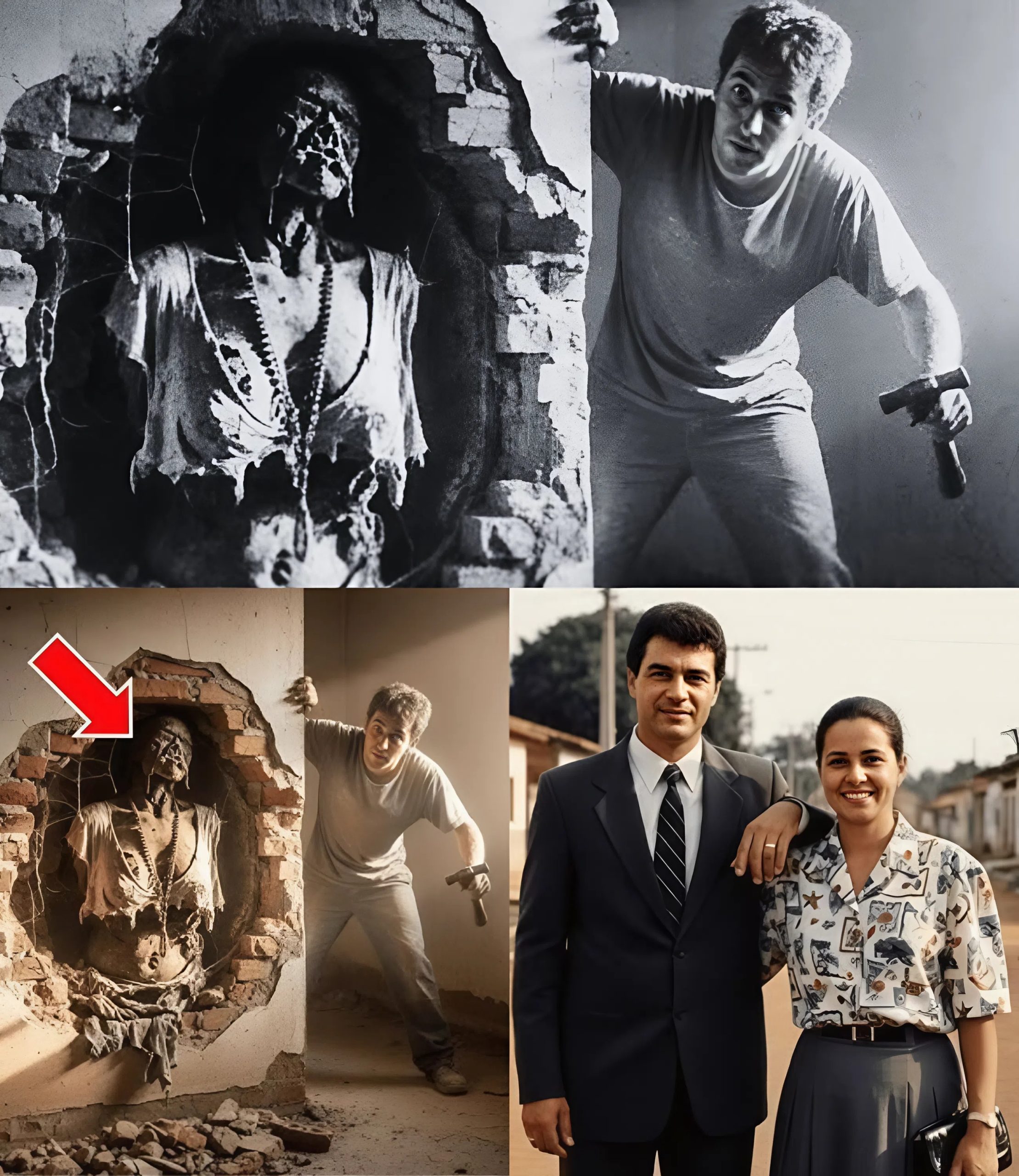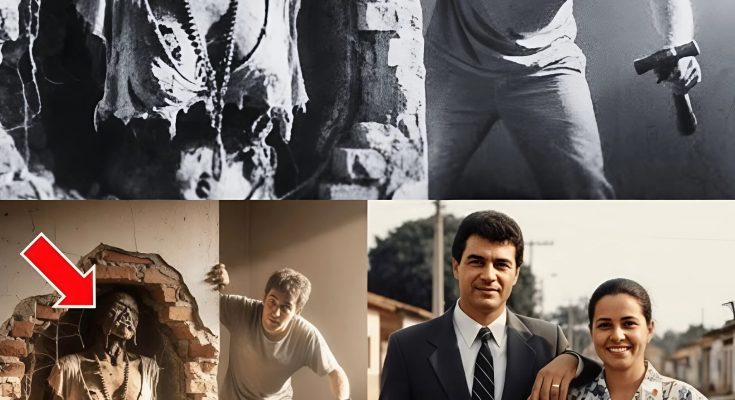The dining room had never changed. The same wooden table bore the same scratches from years of hurried meals, the lace curtains fluttered gently against the glass, and the scent of polished wood lingered like a memory. To any visitor, it was a picture of domestic normalcy — a home untouched by time or tragedy. Yet beneath its calm surface, the unimaginable had been silently waiting for fifteen years: Vitória Mendes, the young woman who vanished without a trace, resting beneath the floorboards of the very house her family refused to sell.
The discovery was almost accidental. It was not a tip from a whistleblower, a new forensic breakthrough, or even a confession. Renovators lifting the floor for minor repairs heard the hollow echo of a space that should not have existed. As the boards were pried away, Vitória’s remains were revealed — carefully hidden, deliberately sealed, and undisturbed for over a decade. The shock reverberated far beyond the Mendes household. Fifteen years of grief, hope, and searching had culminated in the realization that the missing girl had been there all along, literally beneath their feet.

A Case That Haunted a Community
Vitória Mendes disappeared in the early summer of 2008. She was eighteen, full of ambition, and described by friends as radiant and determined. Her disappearance sent shockwaves through her neighborhood and ignited a nationwide search. Flyers were posted across the city, local television stations ran repeated appeals, and social media campaigns emerged long before viral hashtags became common tools in missing-person cases. Every lead was pursued, every rumor investigated. Religious groups held prayer circles; neighborhood volunteers conducted nightly searches; the police chief himself became a public figure synonymous with the case. And yet, despite the exhaustive efforts, Vitória was nowhere to be found.
The fact that she remained hidden in plain sight is almost impossible to comprehend. For fifteen years, the Mendes family continued to live in the home, hosting dinners, celebrating holidays, and walking across the very floorboards that concealed their daughter. The house was a microcosm of denial — outwardly ordinary, yet internally suffused with a tragedy too painful to confront. Psychologists suggest that families experiencing prolonged disappearance often enter a form of collective psychological suspension, a delicate balancing act between hope and denial. The Mendes family may have unknowingly participated in this suspension, preserving the home as it was while avoiding the unbearable thought that Vitória might never return.
The Haunting Role of Authority
Perhaps the most unsettling dimension of this case is the role of the police chief. For years, he led every search, every prayer circle, and every televised appeal. He had walked across the dining room countless times, sipped coffee in that very space, and reassured the public that the investigation remained thorough and diligent. The revelation that Vitória had been beneath that same floorboards casts a shadow over his career, raising questions about competence, oversight, and accountability.
Legal experts caution against rushing to conclusions. Presence alone does not imply guilt. However, the ethical and psychological implications are unavoidable. Could he have noticed something during his visits? Was the oversight a product of systemic failures within law enforcement, or was it a human blind spot, an inability to imagine the ordinary hiding the extraordinary? These questions now dominate public discourse and investigative reviews.

The Anatomy of Deception
The hidden cavity beneath the dining room floor was not an accidental oversight; it was a meticulously concealed space, suggesting planning and knowledge of the home’s architecture. Whoever orchestrated this had intimate familiarity with the house. The concealment raises chilling questions: Was this the work of someone outside the family, or did it involve complicity from within? Investigators are examining every statement, every interaction, and every family dynamic from the past fifteen years to uncover answers.
The case also exposes the limits of conventional investigative approaches. For over a decade, searches focused on expected locations: wooded areas, abandoned buildings, and the outskirts of the city. Residential interiors, especially those belonging to close family, were seldom examined in depth. The assumption that the family would not conceal a loved one may have been a fatal flaw in reasoning. This tragedy underscores the need for investigative paradigms that challenge assumptions, particularly in cases where ordinary domestic spaces may harbor extraordinary horrors.
The Psychological Toll on the Family
The Mendes family is now grappling with a torrent of emotions: grief for the years lost, guilt over the perceived failures to protect, anger at systemic lapses, and the haunting reality of what occurred beneath their home. Fifteen years of holidays, birthdays, graduations, and everyday routines were experienced without Vitória, their absence casting a shadow over every milestone. Psychologists note that families of long-term missing persons often experience “ambiguous loss,” a form of grief compounded by uncertainty. Vitória’s discovery converts ambiguous loss into stark reality — a relief that she is no longer missing, yet a devastation in knowing the depth of what was hidden so close to them for so long.
Neighbors, too, are confronted with unsettling questions. How many signs were missed? Were there noises, smells, or movements that were overlooked or dismissed as mundane? Community members are wrestling with the uncomfortable notion that evil can exist adjacent to normality, that horror can coexist with domestic tranquility.

The Media Explosion
Once the discovery was publicized, the story captivated national attention. Social media erupted with speculation, outrage, and grief. News outlets dissected every element: the wooden table, the lace curtains, the creak of the floorboards, the cups of coffee drunk above a hidden grave. The narrative became emblematic of a society grappling with the intersection of ordinary life and unimaginable horror. Hashtags like #VitóriaMendes and #HiddenHome went viral, fueling debates over responsibility, oversight, and human perception.
Journalists framed the discovery as a story not merely of crime, but of human denial and the limits of observation. The public fascination is understandable: it forces confrontation with uncomfortable truths about domestic spaces, investigative assumptions, and the fragility of human awareness. Ordinary spaces — homes, schools, offices — can harbor secrets invisible to the casual eye, and yet these spaces are often treated as inherently safe. Vitória’s case shatters that assumption.
Broader Implications for Investigations
Vitória Mendes’ tragic story is now shaping discourse around missing-person investigations. Experts advocate for renewed protocols: revisiting old evidence, thorough inspection of domestic interiors, and independent oversight in prolonged cases. Standard assumptions about familial honesty and domestic safety must be questioned when evidence is scarce. The case also highlights the psychological limitations of search operations; investigators, like the public, can be blinded by what they expect to see, overlooking what lies in plain sight.
Architects and criminologists have also taken note. The design of domestic spaces, with hidden cavities and structural idiosyncrasies, can inadvertently enable concealment. This realization may influence future building codes, renovation practices, and investigative methodologies.
Conclusion
The dining room never changed — the table remained scratched, the lace curtains fluttered, and sunlight continued to spill across the polished wood. Yet the discovery beneath it has transformed the space from a symbol of domestic calm into a monument of tragedy, deception, and human oversight. Fifteen years of absence, searches, prayers, and public attention ended not in revelation from afar, but in the hollow echo of a floorboard lifted in routine renovation.
Vitória Mendes’ story is a sobering reminder of the limits of perception, the dangers of assumption, and the hidden complexities of ordinary life. It challenges families, communities, and authorities to confront uncomfortable truths and rethink the assumptions that guide both daily life and investigative work. As the legal and psychological investigations continue, the echoes of that creaking floorboard will resonate far beyond the Mendes household, a haunting testament to the extraordinary hidden within the ordinary.



